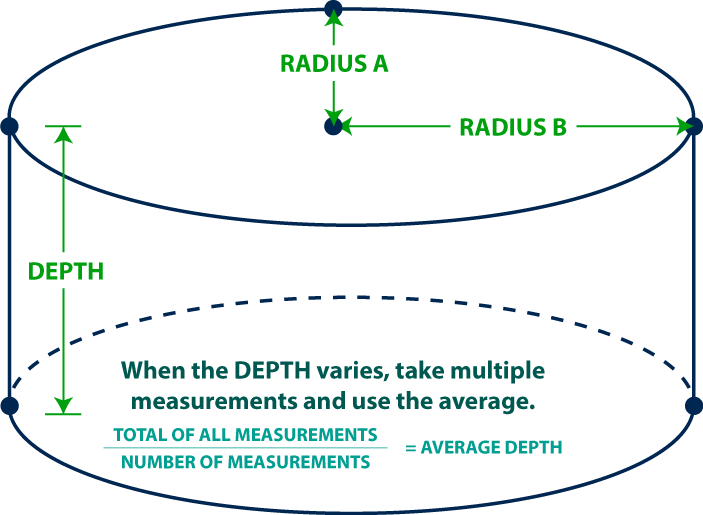

One cubic foot will hold 6.2288 Imperial gallons and there will only be a 0.003% error if the usual approximation of 6.25 gallons is used.

The most accurate way to determine the volume of a pond that has been built to any standard geometrical shape is by measurement. The notable exception is to rapidly restore the pH after a pH crash when any amount of sodium bicarbonate necessary should be added to restore the pH to 7.0 as quickly as possible but no higher until the ammonia level has been checked and the biofilter confirmed to be working (see the method to deal with a pH crash here) The generally accepted maximum rate of change for KH is 20 mg/L per day and this translates to a maximum dose rate of 30 gm of sodium bicarbonate per 1,000 litres. If the KH changes slowly, they can match it without difficulty but it is stressful for them to have to make these changes too rapidly. However, while there is no real upper limit to how much can be used in total, even such a benign chemical shouldn’t be added in too great a quantity at any one time.Īs with changing values of pH, koi are also very tolerant of changing values of KH but have to adjust their internal biochemistry to compensate. Sodium bicarbonate is a pond chemical that is, to all intents and purposes, non toxic unless added in massive amounts and is one of the most convenient ways to add carbonate. However, KH can be raised very easily by adding any one of a range of chemicals that will add carbonates to the water. There are few practical ways to reduce the KH in a koi pond other than by adding reverse osmosis water and the output flow rate of all normal reverse osmosis purifiers is far too low to allow large volumes to be added very quickly. I have not seen any authoritative sources saying that hardness shock will result from reducing KH too quickly but it is well established that hardness shock is a real possibility if it is increased too rapidly. Hardness shock is another possible consequence of adjusting the KH too quickly. If the pH is to be adjusted, the rate of change is best limited to 20 mg/L per day and the pond volume must be known in order that any pH adjustment is carried out safely. As I have repeated many times before, koi can adjust to any pH in the range of 7.0 to 8.5 but, because they have to adjust their internal biochemistry to compensate for different pH values, koi don’t like them to change too quickly. KH buffers such as sodium bicarbonate, which will alter the pH, shouldn’t be added without knowing the pond volume. This gives the security of knowing that there is no real chance of causing harm by overdosing but there is the danger that not knowing the pond volume may lead to under dosing which could potentially leave the koi at risk from the effects of chlorine. Sodium thiosulphate crystals, when used as a dechlorinator, or any of the proprietary dechlorinators based on sodium thiosulphate are non toxic unless used in ridiculous amounts.

#Pond volume calculator full#
However, even when a lower dose rate is chosen, the pond volume must be known in order to determine what the full dose would have been in order to calculate a half of that amount. Again too much may be harmful to the koi or the biofilter although there is one popular product where experience shows that a half or even one quarter dose is often sufficient. It’s also important to add the correct amount of a water treatment, for example, an algae treatment. Too little may not be effective and too much may be harmful or possibly even fatal. We need to know the volume of a pond when it comes to adding a medication for the obvious reason that it is essential that any medication is added at the recommended dose rate. Getting medications and treatments correct


 0 kommentar(er)
0 kommentar(er)
